Emergency Evacuations
Note: The difference between the Designated Emergency Evacuation Shelters and Evacuation Shelters which appear in the text below are as follows:
- Designated Emergency Evacuation Shelters: facilities or places to escape from imminent dangers presented by emergent disasters. Designated by municipal government based on the type of emergency. As a general rule, one base designated emergency evacuation shelter will be made available for use per elementary school district when an evacuation advisory (etc) is announced.
- Evacuation Shelters: Safe places, including friends'/relatives' houses and designated emergency evacuation shelters.
1) Be Prepared: Evacuation Shelters
The City of Hiroshima will not prevent anyone from taking shelter in a designated emergency evacuation shelter, even if they are unwell. We do ask, however, that you wear a mask if you are feeling unwell, and avoid coming into contact with people in the shelter as much as possible. You are also required to speak with reception at the shelter.
Until now, when putting up evacuation information, we have asked for citizens to take shelter at the homes of friends or relatives who are not in danger. To avoid overcrowding at evacuation shelters, we ask that you and your family take a look at the information below and come up with a plan about your evacuation shelter.
(1) Be aware of hazards in your neighborhood
First, check if your home is located inside of a danger zone. Be sure to also check the hazards or danger zones near your workplace, your route to work, places that family members often go to, etc.
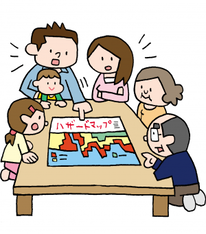
-
広島市土砂災害ハザードマップ
Hiroshima City Landslide Hazard Map (Japanese) -
広島市洪水ハザードマップ
Hiroshima City Flood Hazard Map (Japanese) -
Hiroshima City Disaster Prevention Portal(External link)

- Emergency Evacuation Info/Guide App "Hiroshima Emergency Evacuation Guide"
(2) Decide on an evacuation shelter
Should you need to get to a safe place if your home is located inside of a danger zone, consider evacuating to the following places:
- Safe locations, such as a friend/relative's house in a safe place
- Assembly halls run by your local community or facilities which the local community and facility owner have an agreement
- Designated emergency evacuation shelters (designated by the City of Hiroshima according to the type of disaster)
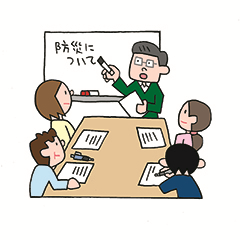
As your family situation changes, so too does the appropriate kind of evacuation shelter. Be sure to hold regular discussions about which evacuation shelter is right for you and your family.
For a list of designated emergency evacuation shelters and more, please refer to the link below.
2) Be Prepared: What to Do During an Evacuation
If your house is located in a danger zone, no matter the situation, you must evacuate to a safe place. However, if you are not prepared for an emergency evacuation, this can be tricky.
Taking into consideration your family (pets included!) and your family's needs, make a plan for what to do in case of an emergency evacuation:
- When will you evacuate?
- Who will you evacuate with?
- Where will you evacuate?
- What should you bring with you?
(1) Check your emergency supplies
Stay prepared for the event of an emergency evacuation: put the minimum amount of things you will need in a backpack and place it somewhere you can get to immediately.
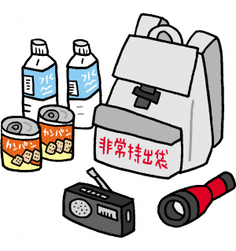
- Bring necessities tailored to your family (infants, grandparents, etc)
- Decide which things are absolutely essential and limit your supplies to those you can carry on the move
- Bring water and food to your evacuation shelter
- Put supplies for each family member in backpacks (to keep your hands free), and put the backpacks in a place which is easy to get to
In order to prevent the spread of infectious diseases, bring masks, disinfectants, sanitizing wet wipes, and a thermometer with you if possible.
For more information on your emergency supply kits and everyday household stockpiles, please see the link below.
(2) Run an evacuation drill
Once you've decided your evacuation shelter, run an evacuation drill there. Even if the shelter is on a road you know well during the day, the situation can become more hazardous and dangerous at night, in heavy rains, or if you have small children with you. Consider these factors as you make your way to your evacuation shelter during your drill.
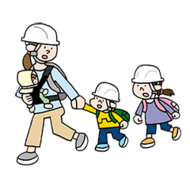
- Using the Waga Machi (Our Town) Hazard Map (Japanese) and other hazard maps, run an evacuation drill to your evacuation shelter
- Come up with several different ways to get to your evacuation shelter
- Decide which routes will be safest under varying conditions (heavy rain, etc)
Try taking a walk in the area around your designated emergency evacuation shelter. When you do go for a walk, be sure to take the necessary precautions against infectious diseases.
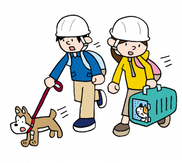
3) Be Prepared: Life in an Evacuation Shelter
When evacuating to a shelter, you may have to spend the night, or even a few days there to wait for the danger to pass (such as heavy rains). In designated emergency evacuation shelters where a large number of people gather to evacuate, it's normal to feel uneasy about the change in circumstances, and it's also easy for panic to set in. In order to avoid these feelings of anxiety and panic, think about what you should do and how you should act to make life easier for everyone.
(1) Be considerate
At designated emergency evacuation shelters, people may be quick to anger or become ill from anxiety and panic caused by unfamiliar circumstances.
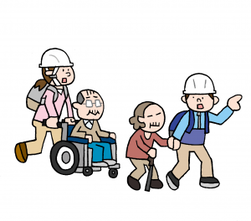
- Show extra consideration to infants, the elderly, and those with physical disabilities.
- If you see someone having a difficult time or someone who is ill, reach out to them or inform reception at your shelter.
- DO NOT slander or discriminate against those who are ill or their families.
- Many times, designated emergency evacuation shelters are understaffed: do what you can to help out if you are able.
4) One Final Note
The City of Hiroshima stays prepared so that our citizens can evacuate to designated emergency evacuation shelters safely, and stay there until it is safe to leave.
We've prepared a booklet of basic information such as how to stay prepared and keep safe during emergencies (earthquake, tsunami, fires, etc). Information on where to get the booklet, along with an electronic version, can be found in the link below:
-
広島市防災普及啓発ハンドブック「たちまち防災」
Hiroshima City Tachimachi Disaster Prevention Handbook (Japanese).
PDFファイルをご覧いただくには、「Adobe(R) Reader(R)」が必要です。お持ちでない方はアドビシステムズ社のサイト(新しいウィンドウ)からダウンロード(無料)してください。
